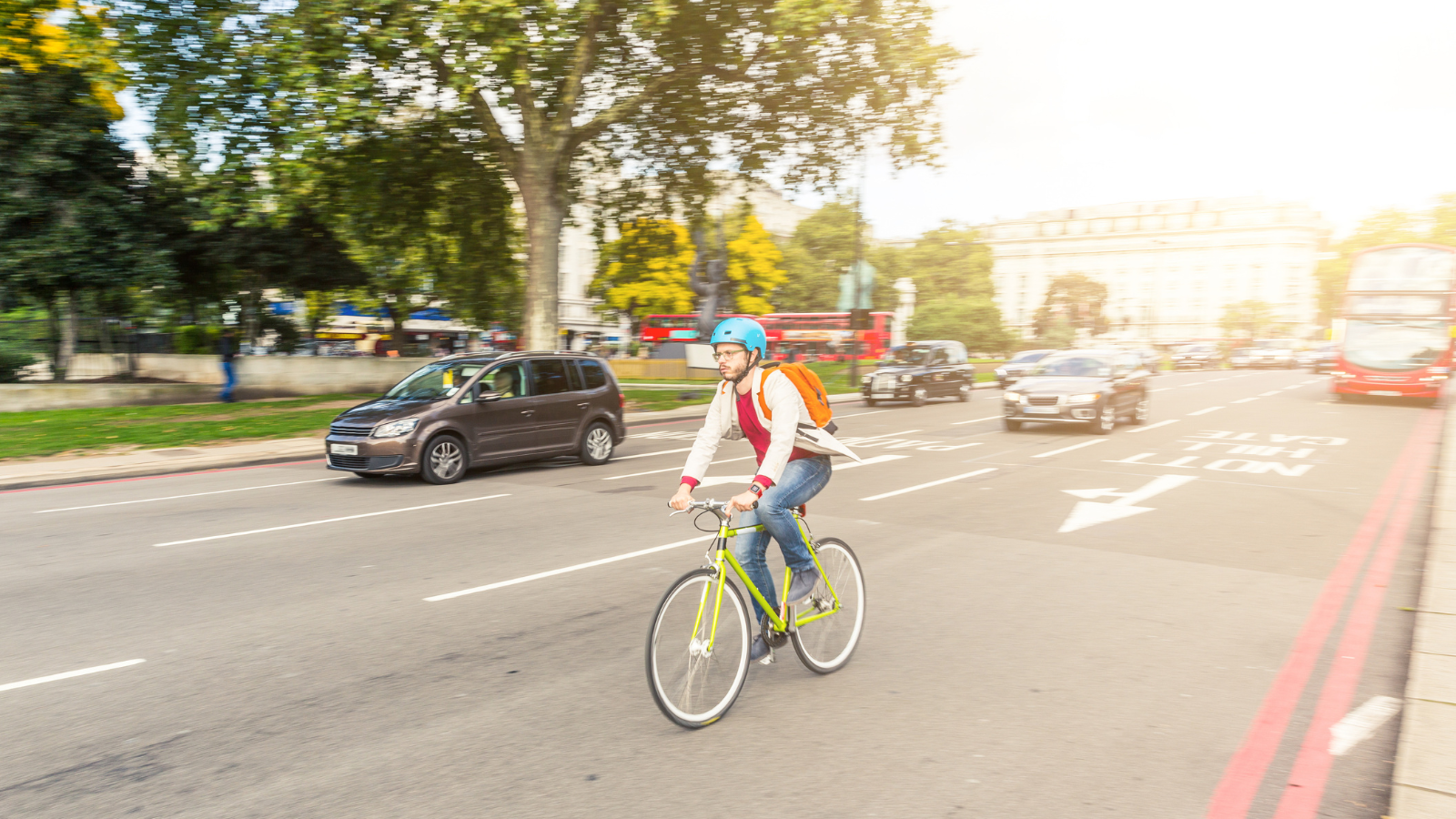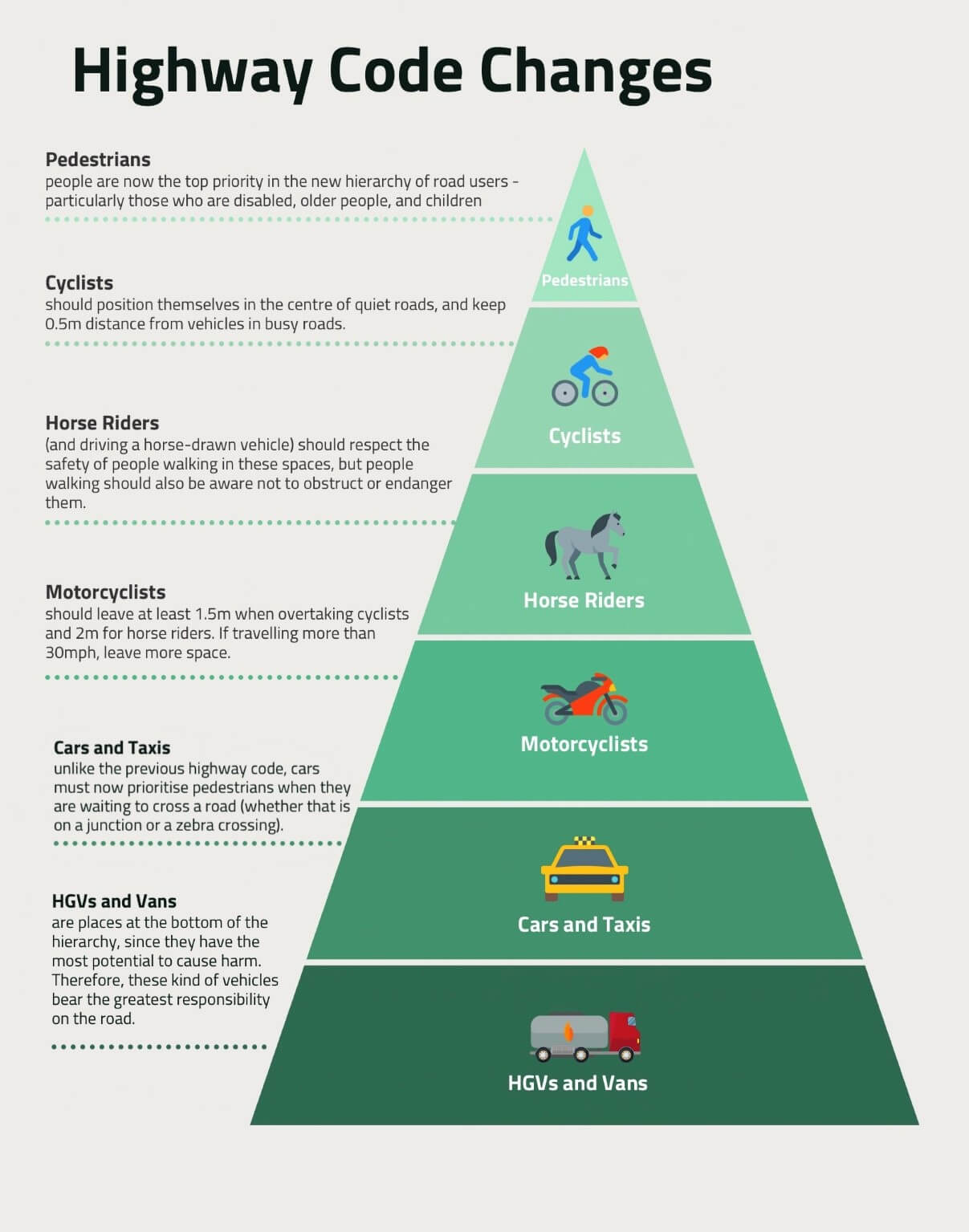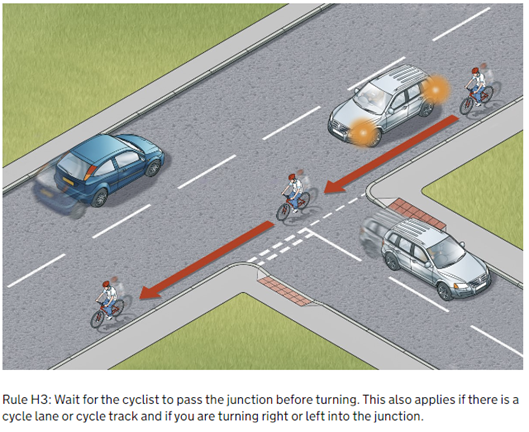
April 11 2024

Did you know that The Highway Code was revised in January 2022? If not, you may not be alone.
What were the changes?
When the Highway Code was updated two years ago, it introduced a ‘Hierarchy of Road Users’ to increase the safety of ‘vulnerable’ road users, such as pedestrians, cyclists, and horse riders. This change was the result of a consultation held by HM Government between July and October 2020 which received approximately 20,000 responses, the vast majority of which supported the proposals.

Image credit: TSO (The Stationery Office) 2024
In essence, the hierarchy is a pyramid style scheme that means drivers of vehicles that cause the greatest harm, such as large goods vehicles (LGVs) or buses, bear the most responsibility to take care of others around them. Those road users most at risk in the event of a collision, recognised as pedestrians, cyclists and horse riders, are at the top of the hierarchy, but it does not remove the need for everyone to behave responsibly and think of their own, and others, safety.
A reminder of the new rules
Within the revised Highway Code there were three new rules, H1, H2 and H3, ten sections were revised, and fifty others were added or updated.
At first glance it seems that Rules H1 to H3 are new and introduce new ideas, but Rule H1 simply describes the new hierarchy.
Rule H2 deals with what road users should do at junctions where pedestrians are waiting to cross, as below. It then reminds road users of their responsibilities in relation to Zebra crossings, shared use cycle tracks and bridleways.

Image credit: TSO (The Stationery Office) 2024
Rule H3 reminds road users that they should not cut across cyclists, horse riders or horse drawn vehicles going ahead when turning into or out of a junction or changing direction or lane, just as they would not turn across the path of another motor vehicle. The rule applies whether a cyclist is using a cycle lane, a cycle track, or riding ahead on the road, and drivers should give way to them. It states, “Do not turn at a junction if to do so would cause the cyclist, horse rider or horse drawn vehicle going straight ahead to stop or swerve.” Drivers should stop and wait for a safe gap in the flow of cyclists if necessary.

Image credit: TSO (The Stationery Office) 2024
The subtlety of language
It is of note that the rules use the words should and MUST, the distinction between which may not be obvious to all. Although many of the new rules do not mandate stopping at junctions or cutting across vulnerable road users, drivers must consider whether their proposed course of action is likely to impede or cause danger to another road user, or whether it is likely to make that road user slow down or change their course. If so, then the proposed course should not be attempted, and you should wait for the other road user to pass, as otherwise this could fall below the standard required of a careful and competent driver.
Have the changes been effective?
According to Rob Hull in This is Money, (01/02/24; see This Is Money), the RAC polled 2500 drivers and 23% of them said they follow the new rules all of the time, 48% said they followed the new rules ‘most of the time’ and 29% didn’t follow the rules either at all or most of the time.
Approximately 18% of those polled thought that the Highway Code changes failed to improve pedestrian safety and almost 31% said that pedestrians actually face greater danger than before. Data from Admiral Care Insurance as reported by Adrian Tatum in Highways News (see Highways-news.com) backs this up: they reported that there was a 16% increase in pedestrian casualties in 2022 compared to 2021, with a 7% increase in fatalities.
Admiral’s research also revealed, on average, only 35% of those surveyed had heard of the new Hierarchy of Road Users guidance by the end of 2022, ranging from 41% of young people down to only 8% of over 65s. Clearly, awareness of the changes was not widespread.
Are pedestrians at increased risk from other road users?
If 18% of drivers believe the Highway Code changes have not worked, and many admit to not following the rule changes themselves, this may well have the effect of reducing pedestrian safety. Of course, pedestrians, cyclists and horse riders should also read and follow the revised rules – not just those in charge of motorised vehicles – but it is possible that only a small proportion have done so. Consequently, there could be situations where pedestrians interact with other road users where only one or the other has read, understood and is practising the revised rules. This leads to a scenario where one does not understand what the other is doing.
For example, consider a driver who has read the Highway Code and is turning into a road where a pedestrian, who is not aware of the new Highway Code, is waiting to cross the road. The driver stops to allow the pedestrian to cross but the pedestrian does not understand why the driver has stopped and remains where they are. The possibility then arises where the driver and pedestrian stay where they are which, in turn, could cause issues with other road users, who may not have read the revised Highway Code; not understanding what is happening, they then try to move past one or the other increasing the possibility of conflict.
The RAC survey showed that approximately 23% of those polled do stop at junctions to allow waiting pedestrians to cross the road, 48% do so most of the time, 19% do so some of the time and 6% do not. This suggests that a lot of drivers ignore the Highway Code provisions and do so at their peril if an incident occurs.
Enforcing Highway Code breaches
If an incident occurs, whether that be a collision or someone reporting another road user for consideration of a possible offence (e.g. via the National Dash Cam Safety Portal), investigators and the courts (both civil and criminal) may take into account what the Highway Code advises. This can be used as the basis for consideration of whether the actions of anyone were careless or dangerous. It can also be used to assess the level of any liability when considering the actions of a road user, whether that be a pedestrian or a driver. This is set out in Section 38 of the Road Traffic Act 1988 (as amended).
Collision investigators already use the Highway Code to establish if a road user may not have heeded its advice. What has recently changed is that the onus falls upon drivers to ensure, as far as possible, that their actions will not place vulnerable as well as other road users in danger.
The new hierarchy and revised Highway Code also gives pedestrians priority when using the footpath, shared spaces and crossing the road, although this was always the case when a pedestrian was crossing the road and is contained within Rule 170 as before. All other road users, including cyclists and horse riders, must give them space and allow them priority.
The need for continued awareness
It is possible that a vast number of drivers, as well as pedestrians, cyclists and horse riders, are still unaware of the rule changes and, as a result, simply cannot put them into practice. The likelihood is that vulnerable road users are less likely to be aware of the changes, especially if they are not drivers. There did not appear to be a lot of information in advance of the publication of the revised Highway Code and it is difficult to know how to address the lack of knowledge at this late stage.
Multiple factors often make up a given incident. These include lighting, weather, speed, driver alertness, expectation, visibility/obstructions, and pedestrian awareness (by way of example, the pervasive use of earphones and headphones reduces pedestrian spatial awareness).
Contact Keith Borer Consultants for an independent review of collision evidence
Our team assists in both criminal and civil matters, and are instructed by insurance companies, police forces and lawyers.